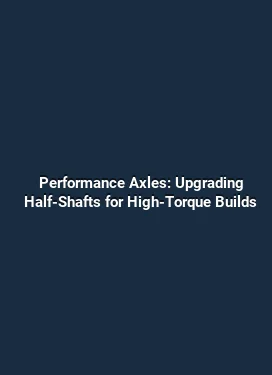Viscous LSD vs Clutch Type LSD vs Torsen Differential: A Thorough Investigation for Transmission & Drivetrain
As performance criteria evolve and vehicle dynamics demand more precise torque distribution, the choice of differential becomes a critical factor in how a vehicle feels in various driving scenarios. This article delves into three widely used differential architectures—viscous LSD, clutch-type LSD, and Torsen differential—exploring their operating principles, performance characteristics, maintenance considerations, and real-world applicability. Emphasizing practical insight, the discussion includes how these systems respond to cornering, acceleration, braking, and road conditions, along with guidance on suitability for street, track, and off-road use.
Foundations of Limited Slip and Torque Transfer: Core Concepts

Torque distribution in a vehicle is governed by the interaction between the engine, transmission, driveshaft, and differential. An open differential permits equal torque to both wheels on a axle but can unintentionally reduce traction if one wheel loses grip. Limited-slip designs address this by biasing torque toward the wheel with better traction, effectively mitigating wheel spin and enhancing cornering stability. Three prevalent implementations—viscous, clutch-type, and Torsen—each leverage distinct physical principles to achieve differential action. Understanding these foundations helps in predicting behavior across driving conditions and selecting a system aligned with performance goals and maintenance expectations.
Viscous LSD: Fluidic Torque Biasing

Viscous limited-slip differentials rely on a viscous coupling built from stacks of plates immersed in a thick fluid. When one wheel begins to slip, the relative rotational speed between the two outputs increases shear within the fluid. The viscous shear forces transmit torque from the faster rotating side to the slower side, effectively locking the axles together to some extent. The degree of lock depends on fluid viscosity, temperature, and the number of plate surfaces engaged in the coupling.
In practice, viscous LSDs tend to offer smooth and predictable torque transfer with subtle intervention. They typically perform well in moderate to high-traction conditions and provide a comfortable ride quality, since the engagement can be gradual and non-violent. However, their effectiveness can wane as fluid temperature rises during spirited driving or track sessions, potentially reducing the bias ratio compared to initial conditions. For street-driven vehicles, a viscous LSD can deliver balanced handling with minimal driver input required for engagement.
Clutch-Type LSD: Mechanical Locking via Friction
Clutch-type limited-slip differentials use a series of clutch plates and a spring or preload mechanism to generate frictional coupling between the left and right wheels. When wheel slip occurs, differential action causes plate friction to increase, transferring torque to the wheel with more grip. The strength of this torque transfer can be tuned through clutch stack height, friction material, and preload settings. This design offers a more immediate and pronounced torque bias compared to viscous types, especially when the clutches engage fully.
Clutch-type LSDs deliver strong, immediate response under hard acceleration or aggressive cornering, which can translate into sharper turn-in and better traction on dry surfaces. They can, however, be more prone to perceptible lock-up or chirp under certain conditions, and clutch wear over time necessitates maintenance. On street cars, a well-tuned clutch-type LSD can provide a dynamic driving feel with clear feedback, particularly in corner exit power delivery.
Torsen Differential: Torque Sensing without Electronics
The Torsen, short for torque-sensing differential, relies on gear mesh and worm gear principles to dynamically bias torque toward the wheel with greater traction. Unlike wet clutches or fluid couplings, a Torsen uses the physical engagement of gears to distribute torque proportionally to load, producing immediate and proportional lock behavior without slip. Torsen units are often praised for their robust performance in a variety of conditions, including snow and light off-road use, due to their continuous and responsive nature.
In terms of performance, Torsen typically provides strong mid-corner stability and predictable torque transfer, with less risk of abrupt engagement compared to some clutch-type designs. Its torque-biasing characteristic is highly dependent on gear ratios and the overall drivetrain layout, but in general, Torsen systems excel in high-traction, high-precision driving environments where instantaneous torque distribution is advantageous.
Performance Characteristics Across Driving Scenarios
Each differential type offers distinct behavior profiles under acceleration, braking, and cornering. A practical comparison can help enthusiasts choose a system that aligns with their preferred driving style and the intended use of the vehicle. The following sections break down key performance attributes, emphasizing real-world impressions and measurable outcomes rather than abstract theory.
Cornering and Turn-in Dynamics
Viscous LSDs tend to deliver a gentle, progressive response when entering a corner. Because engagement is mediated by fluid viscosity, the bias often increases smoothly as slip develops, which can produce a balanced and predictable turn-in with minimal driver input. Drivers frequenting twisty roads may appreciate the understated stabilization without dramatic torque transfer.
Clutch-type LSDs provide more assertive torque distribution during cornering. The friction-based engagement can result in firmer vehicle rotation and quicker exit acceleration, particularly when the driver applies throttle mid-corner. For vehicles used on track days or competitive events, the responsiveness of a clutch-type LSD can translate to faster lap times and heightened steering feel.
The Torsen differential offers near-instantaneous torque bias as wheel loads change within a corner. The result is strong mid-corner grip and confident exit, with a sense of seamless power distribution between wheels. This behavior suits drivers who value precise handling and consistent traction across a range of cornering speeds and surface conditions.
Acceleration and Traction on Diverse Surfaces
In dry pavement, all three systems aim to increase traction versus an open differential, but the magnitude and character of that benefit differ. Viscous units provide a softer, smoother boost that can feel forgiving on street tires. Clutch-type units can deliver a more aggressive shove as the clutches engage, which can be beneficial when acceleration demands high grip. Torsen units typically offer robust traction with minimal slip, translating to aggressive acceleration even when grip is uneven between wheels.
On low-traction surfaces such as wet pavement, snow, or gravel, a well-tuned viscous LSD can maintain steadier torque sharing as slip conditions evolve, while a clutch-type may be more sensitive to temperature and wear, potentially altering engagement behavior. Torsen excels in moderate traction scenarios due to its gear-based distribution, but it can be challenged by extremely low-grip conditions where limited slip is insufficient to prevent wheel spin.
Drive Comfort and Fatigue: Long-Term Behavior
From a daily drive perspective, viscous LSDs generally offer the smoothest and most moderate engagement, contributing to comfortable and predictable handling. This makes them appealing for everyday performance cars where a refined feel matters as much as ultimate traction.
Clutch-type LSDs can introduce a more connected feel and a tangible sense of driving involvement, which many enthusiasts prize. However, the friction materials and assemble tolerances mean wear can introduce gradual changes in bias behavior over time, requiring periodic inspection and potential service intervals to maintain peak performance.
The Torsen differential emphasizes reliability and responsive torque transfer without relying on fluid viscosity or friction plates. Its mechanical nature can translate into a consistent driving characteristic across a wide range of temperatures and driving styles, which many users find desirable for high-performance street and track use alike.
Maintenance, Durability, and Longevity Considerations
Maintenance regimes differ significantly among the three differential types. Understanding service intervals and the factors that influence longevity helps owners plan for performance consistency and cost of ownership. The following considerations focus on practical guidance rather than purely theoretical aspects.
Viscous LSD: Fluid Health and Heat Management
Viscous couplings require attention to fluid condition and temperature management. Over time, fluid viscosity can degrade due to shear, contamination, or aging, diminishing the differential’s effectiveness. Regular fluid checks and replacement, following manufacturer recommendations, help preserve bias characteristics. Heat soak can temporarily reduce coupling efficiency, so adequate cooling and venting are beneficial, especially during spirited driving or track sessions.
Since viscous LSDs lack friction-based stack components, there is generally less wear-related maintenance compared to clutch-type designs. However, seals and internal fluid pathways should be inspected during service to prevent leaks that could compromise performance.
Clutch-Type LSD: Friction Material and Wear Patterns
Clutch-type differentials rely on friction plates that can gradually wear, altering the bias ratio over time. Regular inspection of clutch packs, preload springs, and retaining components is essential. Some owners opt for upgraded clutch materials to achieve a different engagement feel or to withstand higher torque levels. Heat management is important because excessive temperatures amplify wear and can cause clutch glazing, reducing performance and increasing the risk of slip under load.
Correct torque bias and alignment are critical for reliability. Mismatched components, improper preload, or uneven wear can lead to noise, chatter, or inconsistent behavior. Routine lubrication checks and following service intervals for fluid replacement and seal integrity help maintain optimal performance.
Torsen Differential: Structural Integrity and Gear Wear
The Torsen’s gear-based mechanism tends to be robust and durable, with fewer consumable friction components than clutch-type systems. However, the gears, bearings, and housings must withstand sustained torque transmission, and improper installation can lead to noise or premature wear. Maintenance typically centers on inspection for gear backlash, bearing health, and oil quality. Regular oil changes with the correct specification help preserve gear meshing and reduce heat buildup that can accelerate wear.
Practical Guidance: Selecting the Right Differential for Your Vehicle
Choosing among viscous, clutch-type, and Torsen differentials depends on driving goals, climate, tire technology, and maintenance willingness. The following decision framework can aid in aligning a differential choice with the vehicle’s mission and the owner’s expectations.
Street-Driven Performance Cars and Everyday Rally
For drivers prioritizing a balanced, quiet, and easy-to-live-with experience, a viscous LSD offers a good blend of traction enhancement and smoothness. The fluid-based engagement minimizes abrupt transitions and can preserve comfort in daily commuting while still delivering improved grip in corners and during modest launches.
Track-Ready and Enthusiast-Oriented Builds
Clutch-type LSDs shine in track environments where decisive power transfer and aggressive handling responses are valued. The ability to tune engagement through clutch stacks and preload allows for bespoke feel and performance characteristics. Clubs, track days, and competitive events often favor clutch-style units for their direct feedback and controllable bias under high load.
All-Weather Duty and High-Precision Handling
Torsen differential installations are well-suited to vehicles requiring immediate, proportional torque distribution across a range of temperatures and conditions. They excel in all-weather performance and can provide a confident driving experience where electronic aids are limited or avoided. For owners seeking a more predictable, consistent feel with less maintenance, Torsen can be an appealing choice.
Trend Considerations and Semantics in Modern Drivetrain Discourse
In contemporary vehicle dynamics discussions, several themes intersect with differential choices. The emphasis on traction-focused design, torque vectoring compatibility, and thermal management informs how modern drivetrains are engineered. While venturing beyond surface-level definitions, the practical implications of differential architecture become evident in how a car communicates grip, precision, and acceleration behavior to the driver. Observing how these systems integrate with suspension tuning, tire choice, and chassis stiffness reveals a holistic approach to performance engineering that goes beyond isolated component comparisons.
Practical Examples and Real-World Scenarios
Consider a high-performance sedan that sees mixed-use driving: daily commuting, spirited canyon runs, and occasional track sessions. A viscous LSD can deliver a compliant street experience with reliable cornering grip, while a clutch-type LSD might reward aggressive drivers who prioritize lock-up strength during hot-lap corners. For a sports-focused AWD setup that benefits from quick, proportionate torque distribution without relying on electronic aids, a Torsen differential can provide a balanced, direct feel under diverse conditions. Each choice shapes the driver’s sense of control and the vehicle’s ability to exploit tire contact with the road surface.
Tuning, Aftermarket Potential, and Component Synergy
Aftermarket enhancements—such as selective clutch material upgrades, pre-load adjustments, or even differential cooling solutions—can tailor behavior to specific use cases. Some drivers adopt lightweight, low-friction fluids to minimize temperature rise in viscous units, while others experiment with spring rates and preload in clutch-type units to tune engagement thresholds. In all cases, compatibility with the vehicle’s drivetrain architecture and the overall balance with suspension, braking, and tire setup remains crucial for achieving the desired performance outcome.
Conclusion-Oriented Yet Open-Ended: Emphasis on Informed Decision-Making
While each differential type offers distinct advantages, the optimal selection hinges on a thorough evaluation of driving goals, environmental conditions, and maintenance expectations. The viscous LSD provides smoothness and reliability in everyday use, the clutch-type LSD delivers aggressive engagement and tunable feel for performance driving, and the Torsen differential offers robust, driver-friendly torque distribution without relying on friction-based engagement. By aligning not only with performance metrics but also with comfort, durability, and ownership costs, enthusiasts and professionals can make informed choices that harmonize with their vehicle’s design philosophy and intended role on the road or track.






